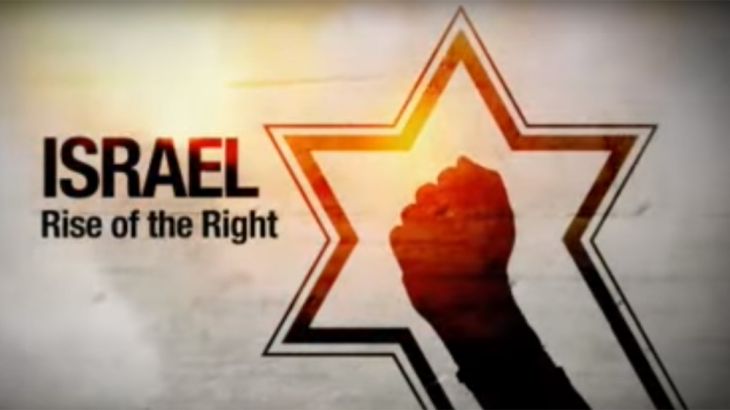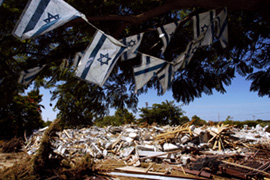
Israel: Rise of the Right
An exclusive insight into Israel’s extreme right wing settler movement.
Ilan Mizrahi is an Israeli photojournalist who has spent 16 years photographing and filming right wing Israeli settlers in the West Bank city of Hebron.
His film, Israel: Rise of the Right, looks at the followers of Rabbi Meir Kahane, an American-born rabbi and politician who proposed the mass expulsion of Arabs from Israel before he was assassinated in 1990.
Keep reading
list of 4 items‘Feel less and less like playing’: Vinicius Jr in tears over racist abuse
‘Rendered invisible’: A wave of anti-Arab violence tests US hate crime laws
Germany bans far-right Austrian nationalist Martin Sellner from entry
WATCH PART TWO:
FILMMAKER’S VIEW
By Ilan Mizrahi
| In Depth |
Nine months ago, I was asked to make a documentary about the extreme right in Israel. That was before the war in Gaza and the Israeli elections, but it was already apparent to most that the right wing bloc led by Binyamin Netanyahu would form the next government.
Israel has had right wing prime ministers before. Elected in 1977, Menachem Begin was the first right wing politician to become Israeli prime minister.
He was also the first to make peace with an Arab country.
I was just four years old when Anwar Sadat, the then Egyptian president, came to Israel for the first time, but I recall my parents excitedly watching the event on television.
Like most Israelis, I was drafted into the army when I graduated from high school.
As a soldier, I was posted to many different places, but Hebron was by far the most intriguing.
The largest city in the West Bank, it is home to about 180,000 Palestinians and more than 500 Israelis. The two communities live side-by-side, fighting each other for every little bit of land.
During my time there I came to know both communities.
It did not take me long to realise that Hebron was one of the craziest places I would ever visit. What I did not know then was that this would be the beginning of a 16-year relationship with the city and its residents.
WATCH PART THREE:
‘The barrel of explosives’
During the 19th century, Jews and Arabs lived together peacefully in Hebron.
![Pictures of Baruch Goldstein, left, and Rabbi Kahane at a house in Hebron [Ilan Mizrahi]](/wp-content/uploads/2009/06/2009627114432535876_3.jpeg)
But after the Ottoman Empire’s defeat in the First World War, Palestine came under British rule. With this change, the Jews and Arabs of the area developed nationalistic aspirations to the land.
On the Jewish side, there was the World Zionist Organisation led by Chaim Weizmann, whose dreams were realised with Lord Balfour’s watershed declaration that “His Majesty’s government view with favour the establishment in Palestine of a national home for the Jewish people”.
On the Arab side was the Arab Higher Committee led by Hajj Amin al-Husayni, who called the local Arabs to fight for their right to the land and drive out of Palestine both the Jews and the British occupiers.
In August 1929, 69 Jewish residents of Hebron were massacred by their Arab neighbours. The remaining Jews left the city but returned in 1931.
When the next wave of violence erupted in 1936, the Jews left Hebron again. They did not return until after the 1967 Six Day War when Israel took over the Golan Heights from Syria, the Sinai Peninsula and Gaza Strip from Egypt and the West Bank and East Jerusalem from Jordan.
A few hundred have since settled there but repeated clashes between the Jewish and Arab residents have earned ‘the City of the Patriarchs’ a new nickname – ‘the barrel of explosives’.
WATCH PART FOUR:
Kahane
As tensions between the two communities escalated, the city became the centre for an extreme right wing movement led by Rabbi Meir Kahane, an American-born rabbi who was elected to the Israeli parliament in 1984 and advocated the removal of all Arabs from Israel and the West Bank.
Kahane was assassinated in Manhattan in 1990 but his followers continue to espouse his ideology.
For some of the Kahane followers the fact that Goldstein had been my doctor while I served in Hebron upgraded me and my camera to a better position in their eyes,
The 1993 Oslo peace talks between Israelis and Palestinians shocked the settler community living in Hebron and elsewhere in the West Bank and Gaza Strip and threatened to shatter their 2,000-year-old dream of rebuilding their homes on all the land they believe was promised to them in the Bible.
In 1994, a few weeks after my release from the Israeli army, a man from Hebron’s Jewish settlement entered the Cave of the Patriarchs in Hebron and shot dead 29 Palestinian Muslim worshippers during their Friday prayers.
The gunman, Dr Baruch Goldstein, was killed by the crowd.
Goldstein was a follower of Rabbi Kahane and a member of the local council of the Kiryat Arba settlement in Hebron. He was also a reservist army doctor at the Israeli military headquarters in Hebron.
When I saw his face on television, I recognised him as the doctor who had treated me when I was a soldier.
Through his act, Goldstein had tried to stop the Oslo peace talks but he instead achieved the opposite, deepening hostility toward the right wing settlers among mainstream Israelis.
The massacre at the Cave of the Patriarchs was also followed by a wave of Hamas-led terror attacks on major Israeli cities. These provided Hamas with a convenient platform on which to gain support among moderate Palestinians.
Political divide
By that time, I had become a photojournalist and I went to cover the large right wing demonstration against Yitzhak Rabin, the then Israeli prime minister who was still trying to reach a peace agreement with the Palestinians at Oslo.
![Kahane follower Itamar Ben Gvir during his wedding to Ayala [Ilan Mizrahi]](/wp-content/uploads/2009/06/200962795038360833_3.jpeg)
At that demonstration, I saw – for the first time in my life – the wide gap between the political left and right in Israeli society.
It was also the day that I had my first photograph published in a major Israeli newspaper.
In the years since, I have photographed settler communities almost every week.
With time, I built mutual trust with some of the settlers, including Itamar Ben Gvir, a young Kahane follower who gained fame when he jumped on Rabin’s car and yanked off the Cadillac symbol during a demonstration.
Ben Gvir told the media that if they could get to Rabin’s car, they would get to him too.
A few weeks later, Rabin was assassinated by a right wing Jewish extremist called Yigal Amir. He was not a settler.
Entering their world
In 2004, Ariel Sharon, the then Israeli prime minister, decided to evacuate all Jewish settlers from the Gaza Strip, where they had lived since settlements were established in the early 1970s.
By that time, I had a video camera and decided, more than a decade after his assassination, to make a film about Rabbi Kahane’s followers.
I started by asking Ben Gvir to help me enter his world. He invited me to his wedding, where I met most of the current followers of Kahane.
The Kahane movement was outlawed in Israel and the US after Goldstein’s attack. This made it a difficult subject to document. Many of the people I wanted to film were afraid that I was working for the Israeli Shin Bet (secret service).
During the five years of filming, I was frequently interrogated – often before I could even get my camera out of the car. Some of those I filmed were obsessed with my own political views; others just hated me for being a journalist.
One of the things that was most difficult for me to understand – and film – was the admiration still felt for Goldstein and the yearly celebration at his grave in Kiryat Arba.
For some of the Kahane followers, the fact that Goldstein had been my doctor while I served in Hebron upgraded me and my camera to a better position in their eyes.
Shattered dreams
In August 2005, Eden Natan Zada, an awol soldier and Kahane follower, shot dead four Palestinian-Israelis on a bus in an attempt to stop the Israeli disengagement from the Gaza Strip.

He did not achieve his goal and Kahane’s followers were, once again, back on the security forces’ black list.
After Israel’s disengagement from the Gaza Strip, the settler community and right wing parties were left reeling from the knockout blow delivered by their own government.
Many thought Israel would withdraw from other territories as well and that the settlement issue would soon be over.
But the kidnapping of Israeli soldiers by Hamas in the Gaza Strip and Hezbollah in Lebanon saved Israel’s right wing politicians like Binyamin Netanyahu.
Netanyahu did not include in his government the extreme right wing National Union party, which won four seats in parliament.
One of the party’s members of parliament is Michael Ben Ari, a doctor of archeology who had been a student of Rabbi Kahane and still follows his ideology today.
Ben Ari was supported in his campaign by two of the main forces behind the Kahane movement today – Hebron residents Itamar Ben Gvir and Baruch Marzel. The two now serve as his parliamentary assistants.
Seat of power
Over the past few months, I have filmed the Kahane followers as they fought the Israeli police at the Supreme Court for their right to march through the Arab-Israeli town of Umm el-Fahem.
They won their appeal and eventually marched through the town.
When I arrived in Umm el-Fahem to cover the event, the town’s Arab residents looked at me with the same suspicion the Kahane followers displayed when I first began filming them.
When asked by local residents for whom I was filming, I knew that being a young Jewish Israeli man, no one would believe me if I had answered that it is for Al Jazeera.
Nearly two decades after his death, Rabbi Meir Kahane’s ideology is still alive. But his followers are a small group who are largely rejected by mainstream Israeli society.
When Netanyahu gave his recent speech at Bar Ilan University, many – including Barack Obama, the US president – listened carefully, waiting to hear whether he would utter the words “two-state solution”.
When he did say them, albeit with reservations, many among the settler community realised that their dream of controlling all of the Biblical land of Israel was again on the line.
Today, after years spent getting to know Kahane’s followers, I am sure that they will remain loyal to their rabbi’s ideology and will fight against a two-state solution, as they have in the past with other Israeli governments.
But this time they will be fighting from within the seat of power.
The views expressed by the author are not necessarily those of Al Jazeera.